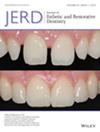Color Matching and Stability of Single-Shade Chameleon Dental Composites: A Systematic Review
Abstract
Objective
This systematic review evaluates the color-matching ability (ΔE 00 values) and chromatic stability of single-shade chameleon dental resin composites in restorative dentistry.
Methods
A comprehensive search of PubMed, Scopus, Web of Science, Embase, and Cochrane Library was conducted following PRISMA guidelines. Studies assessing color adaptation and stability of single-shade composites in vitro, in clinical trials, and in retrospective analyses were included.
Results
Seven studies (four in vitro, two clinical trials, one retrospective study) reported ΔE 00 values within clinically acceptable thresholds (< 3.3). Clinical trials showed that single-shade composites (e.g., Omnichroma, Vittra APS Unique) achieved comparable aesthetic outcomes to multi-shade composites over 12–18 months. Factors such as staining agents and cavity depth influenced color stability, with coffee exposure causing the most discoloration. Bleaching procedures induced minimal color shifts. Study heterogeneity limited meta-analysis.
Conclusion
Single-shade chameleon resin composites provide reliable color adaptation and stability, streamlining shade selection and reducing clinical time. However, staining susceptibility and restoration depth must be considered for long-term aesthetic success.
Clinical Significance
Single-shade chameleon composites simplify shade selection, reducing chair time and enhancing efficiency in restorative dentistry. However, clinicians should consider staining susceptibility and restoration depth to ensure long-term aesthetic stability.

 求助内容:
求助内容: 应助结果提醒方式:
应助结果提醒方式:


